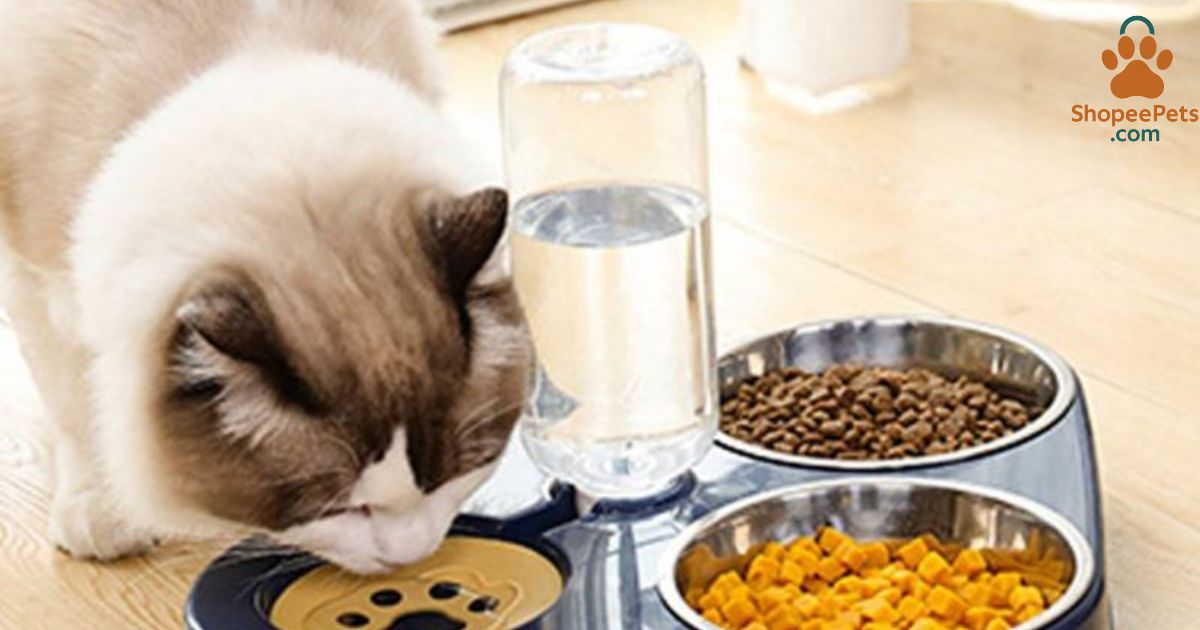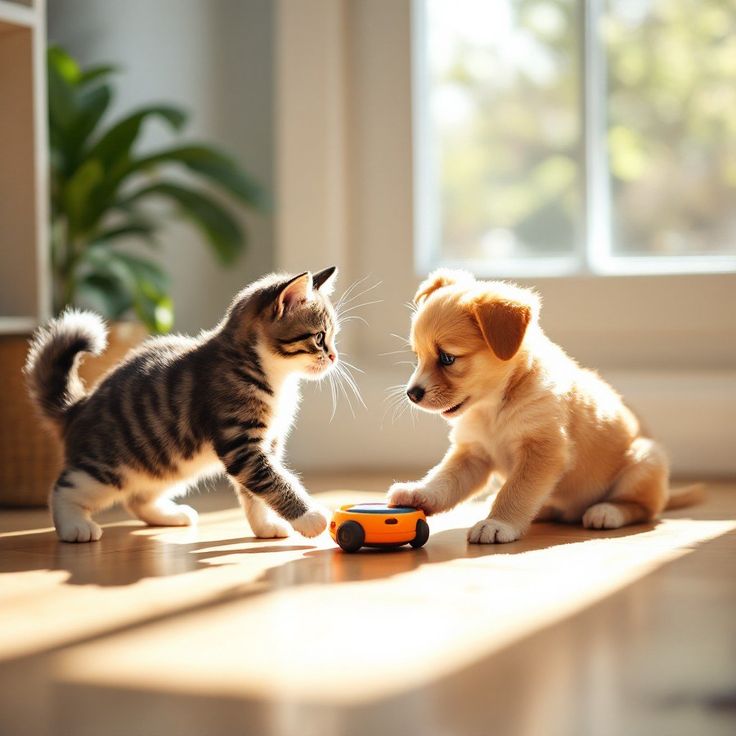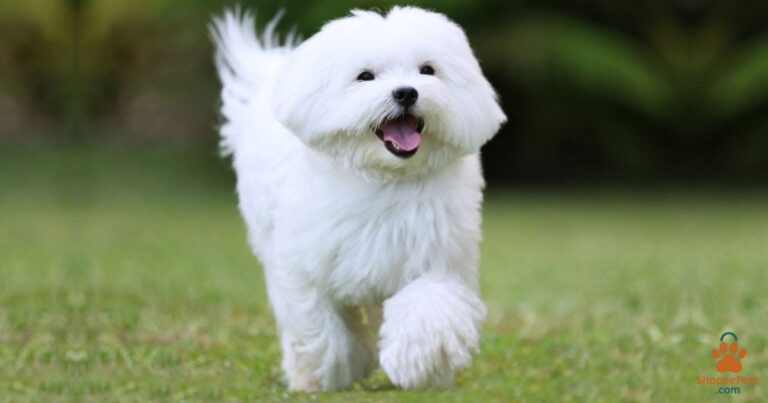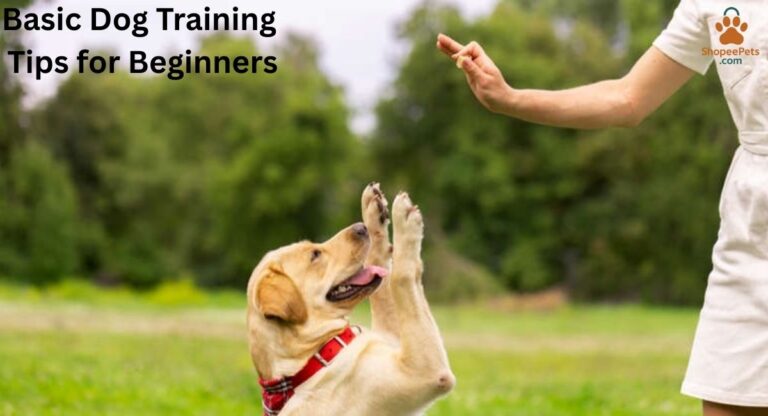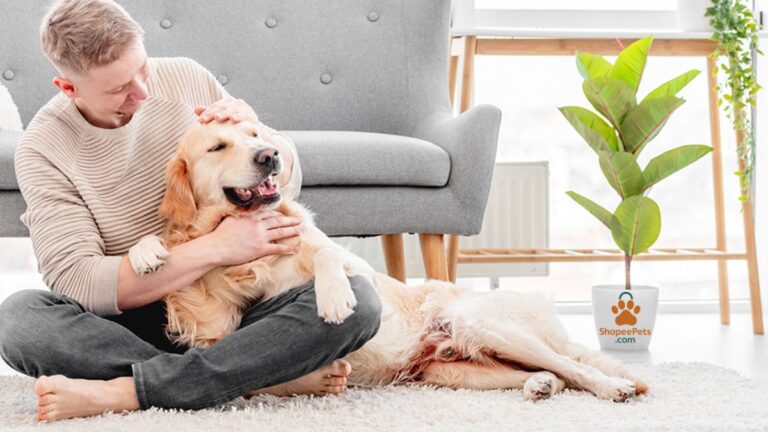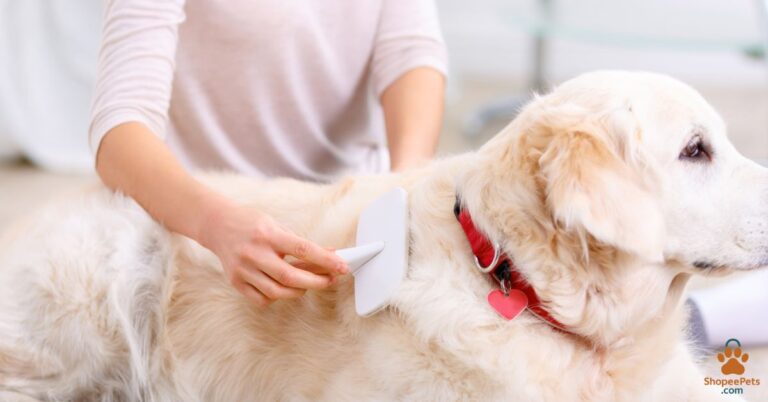Wet Cat Food vs. Dry Cat Food: Which Is Better for Your Cat?
Choosing the right food for your cat is one of the most impactful decisions you will ever make as a pet parent. A cat’s diet doesn’t just fill the food bowl—it directly affects their energy, hydration, immune system, and overall lifespan. For indoor cats especially, selecting the best cat food for indoor cats is crucial, since their activity levels, nutritional needs, and health challenges are very different from outdoor cats. When it comes to nutrition, the biggest question most owners ask is:
“Is wet cat food healthier than dry cat food?”
Both wet and dry food have their unique advantages and drawbacks. Some owners prefer the convenience of kibble, while others swear by the hydration benefits of canned meals. The truth is that the answer isn’t black-and-white. Your cat’s age, health, weight, and lifestyle all play a role in deciding which option is best.
In this guide, we’ll take a professional deep dive into wet vs. dry cat food—covering nutrition, hydration, veterinary advice, pros and cons, comparisons, and practical feeding tips. By the end, you’ll be confident about making the best choice for your furry friend.
Understanding the Basics of Cat Nutrition
Cats are obligate carnivores, which means they must eat animal-based protein to survive. Unlike dogs, they cannot thrive on plant-heavy diets because their bodies are designed to extract nutrients from meat.
Essential Nutrients Every Cat Needs
- High-quality protein – The building block of muscles, organs, and healthy skin. (Chicken, turkey, fish, beef, lamb)
- Animal fats – Provide energy and essential fatty acids for a shiny coat and strong immunity.
- Taurine – An amino acid found in animal tissues. A deficiency can lead to blindness or heart disease.
- Vitamins & minerals – For bone health, metabolism, and cellular repair.
- Water – Crucial for hydration, kidney health, and overall body function.
👉 Unlike dogs, cats often don’t drink enough water on their own, making diet-based hydration extremely important.
Calories and Weight Balance
According to the World Small Animal Veterinary Association (WSAVA), the average 10-pound healthy adult cat requires 240–270 calories per day. Too few calories cause malnutrition and weakness, while too many lead to obesity—a growing problem among pet cats in the USA and UAE.
⚡ Fun fact: Over 59% of cats in the United States are overweight or obese (Association for Pet Obesity Prevention, 2023). This makes choosing the right food even more critical.
📌 Read more: Best Dog Food for Small Breeds – ShopeePets
What Is Wet Cat Food?
Wet cat food—also known as canned food—is made with high water content, usually between 70–80%. This closely mimics the moisture levels found in a cat’s natural prey, like mice or birds.
How It’s Made
Wet food is typically made by combining meat, vitamins, and minerals, then sealing and cooking it inside cans or pouches to preserve freshness without chemical preservatives.
Why Cats Love It
- Strong aroma makes it more appealing
- Softer texture—ideal for kittens, seniors, or cats with dental problems
- Moisture-rich—supports hydration
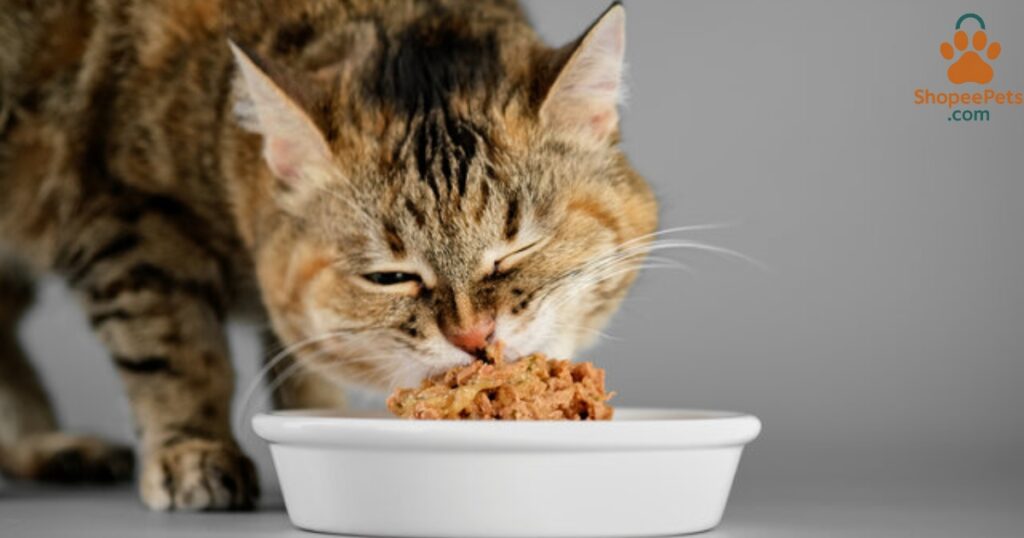
Benefits of Wet Cat Food
Wet cat food isn’t just tasty—it can be life-changing for cats with certain health needs.
1. Improved Hydration
Cats naturally have a low thirst drive. In the wild, they rely on prey for hydration. Wet food provides water directly in the meal, helping prevent urinary tract infections (UTIs), bladder stones, and kidney disease.
🔗 Reference: WSAVA Global Nutrition Committee
2. Supports Weight Management
Since wet food has fewer calories per gram, cats can eat a larger volume without consuming excess calories. This makes them feel fuller while helping to prevent obesity.
3. Easier Digestion for Sensitive Cats
Cats with sensitive stomachs or older cats with weak teeth find wet food easier to chew and digest.
4. Better for Cats with Health Conditions
- Diabetes – Controlled portions of wet food help regulate blood sugar.
- Urinary issues – Added moisture supports bladder health.
- Kidney disease – Hydration is critical for slowing disease progression.
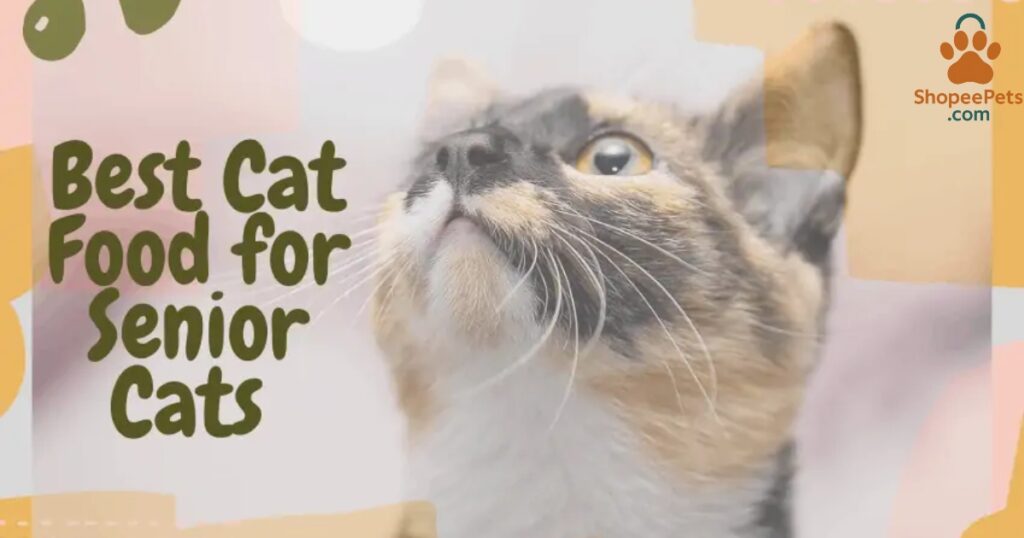
Drawbacks of Wet Cat Food
While beneficial, wet food does have limitations:
- Cost – Significantly more expensive than kibble.
- Shelf Life – Spoils quickly once opened. Needs refrigeration.
- Messy Feeding – Leftovers dry up, bowls need more frequent cleaning.
- Dental Concerns – Does not promote chewing like dry food, which may lead to plaque buildup if dental care isn’t managed.
📌 Tip: Combine wet food with regular tooth brushing or dental treats to balance oral health.
👉 Read: Cat Grooming Tips – ShopeePets
Table: Wet Cat Food at a Glance
| Factor | Benefit | Drawback |
|---|---|---|
| Hydration | Provides 70–80% water, reduces risk of kidney & urinary issues | None, hydration always positive |
| Calories | Lower density, helps weight control | May not provide enough energy for very active cats |
| Palatability | Strong aroma, loved by picky eaters | Can make cats “too picky” about kibble later |
| Cost | Great for health management | More expensive long-term |
| Shelf Life | Fresh and moist | Spoils fast after opening |
Myths About Wet Cat Food
- ❌ “Wet food makes cats fat” – Not true. Overfeeding of any type makes cats overweight.
- ❌ “It causes dental problems” – Lack of dental care, not wet food itself, is the issue.
- ❌ “Dry food is more complete” – Both wet and dry can be balanced if they meet AAFCO standards.
📌 Resource: AAFCO Pet Food Standards
Expert Vet Opinions on Wet Food
Many veterinarians recommend including wet food in every cat’s diet, especially for:
- Cats with urinary or kidney issues
- Senior cats who drink less water
- Overweight cats needing portion control
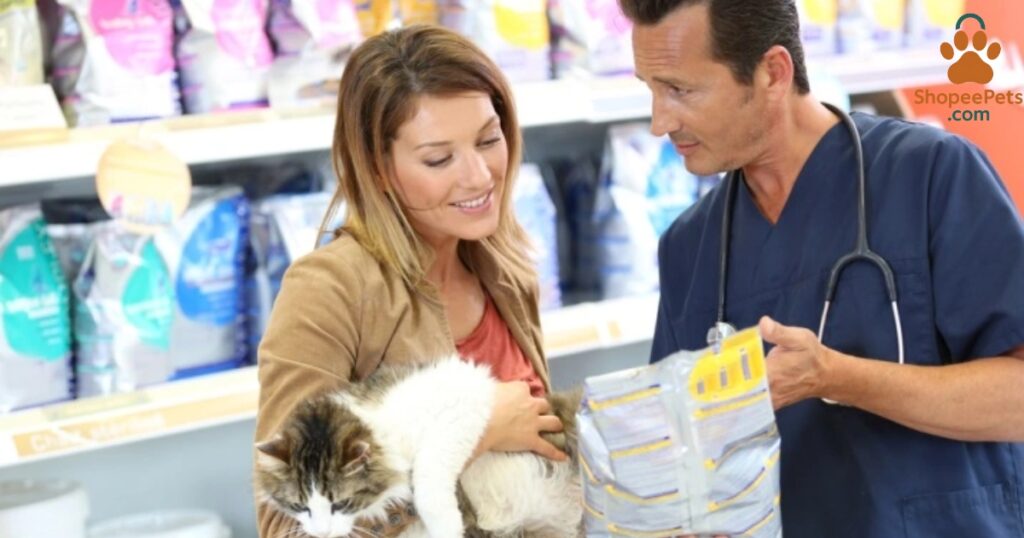
Feeding Tips for Wet Food
- Feed in smaller portions – Cats prefer multiple small meals a day.
- Refrigerate after opening – Use within 24–48 hours.
- Warm before serving – Cats enjoy food at body temperature (~100°F).
- Mix with kibble if needed – To balance convenience and hydration.
- Monitor body condition score – Adjust portions if your cat gains or loses weight.
📌 Read: Pet Care Tips – ShopeePets
What Is Dry Cat Food (Kibble)?
Dry cat food, also known as kibble, is a popular choice among pet parents because of its convenience and affordability. It contains around 10% water and is calorie-dense, meaning cats need smaller portions to get the same energy compared to wet food.
How Kibble Is Made
The process, called extrusion, involves:
- Mixing meat, grains, and supplements into a dough.
- Cooking the mixture under high heat and pressure.
- Shaping into small crunchy pieces.
- Spraying with fats and flavor enhancers to make it palatable.
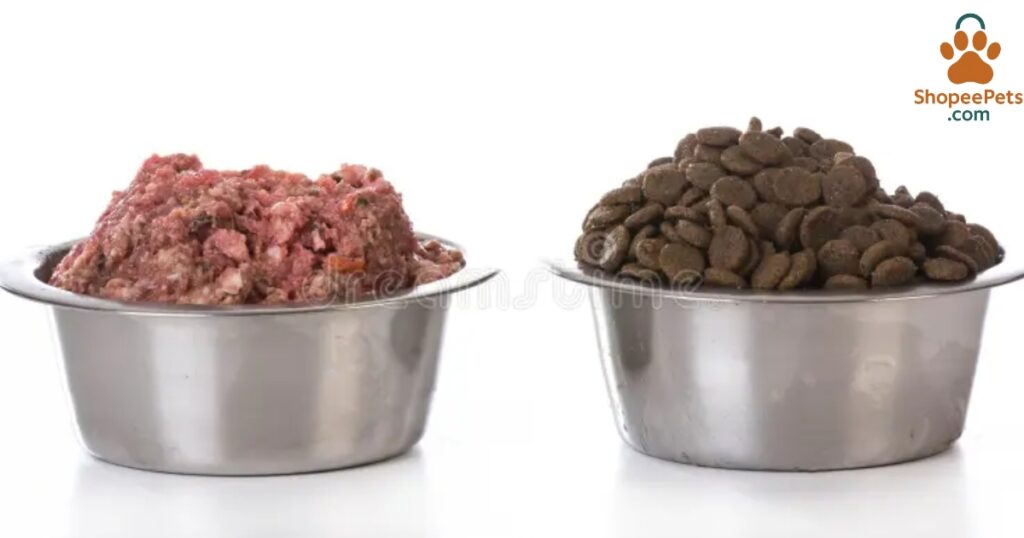
Benefits of Dry Cat Food
- Convenience for Owners
- Can be left out longer without spoiling.
- Easy to store and transport.
- Cost-Effective
- More affordable than canned wet food.
- Great option for multi-cat households.
- Dental Support
- Crunchy texture may reduce plaque buildup.
- Special “dental diets” are designed to clean teeth more effectively.
- Calorie Density
- Packed with energy, making it ideal for very active cats or outdoor cats.
📌 Read more: Dog Training Tips – ShopeePets
Drawbacks of Dry Cat Food
- Low Moisture Content
- With only 10% water, kibble may lead to chronic dehydration if cats don’t drink enough water.
- Dehydration increases the risk of urinary tract disease and kidney problems.
- Overeating & Obesity
- Calorie-dense food makes it easy to overfeed.
- Free-feeding (leaving food out all day) often causes weight gain.
- Potential Use of Fillers
- Some brands use excessive grains or plant proteins, which are less suitable for obligate carnivores.
- Dental Benefits Are Limited
- While kibble helps some cats, it does not replace brushing or professional dental care.
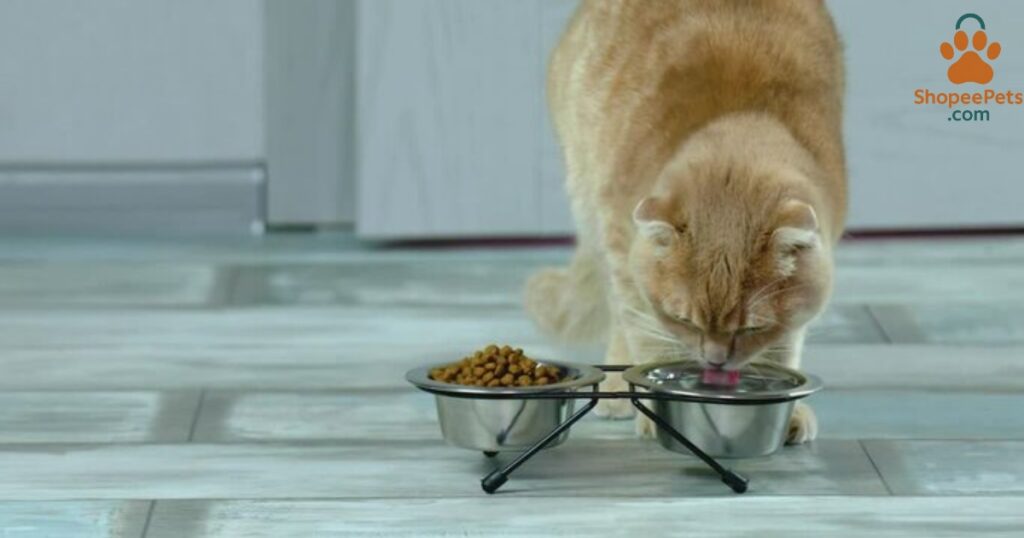
Table: Dry Cat Food at a Glance
| Factor | Benefit | Drawback |
|---|---|---|
| Convenience | Easy to store & feed | None |
| Shelf Life | Lasts for weeks without spoiling | Overeating risk if free-fed |
| Cost | Affordable for most owners | May compromise quality in cheap brands |
| Hydration | None needed from food | Increases dehydration risk |
| Calories | Energy-rich for active cats | Can cause obesity if overfed |
Wet vs. Dry Cat Food: A Detailed Comparison
Now that we’ve looked at both wet and dry food individually, let’s compare them side by side.
1. Hydration & Kidney Health
- Wet food: Provides built-in hydration, reducing urinary tract problems.
- Dry food: Requires cats to drink water separately, which many don’t do enough.
📌 Resource: National Research Council – Nutrient Requirements of Cats
2. Calories & Weight Management
- Wet food: Lower calorie density, great for cats prone to obesity.
- Dry food: Higher calorie density, better for very active cats.
3. Dental Health
- Wet food: Does not naturally clean teeth; brushing required.
- Dry food: Crunchy texture can help but is not a replacement for dental care.
4. Cost & Budget Planning
- Wet food: More expensive, especially with premium brands.
- Dry food: Budget-friendly, especially for multi-cat homes.
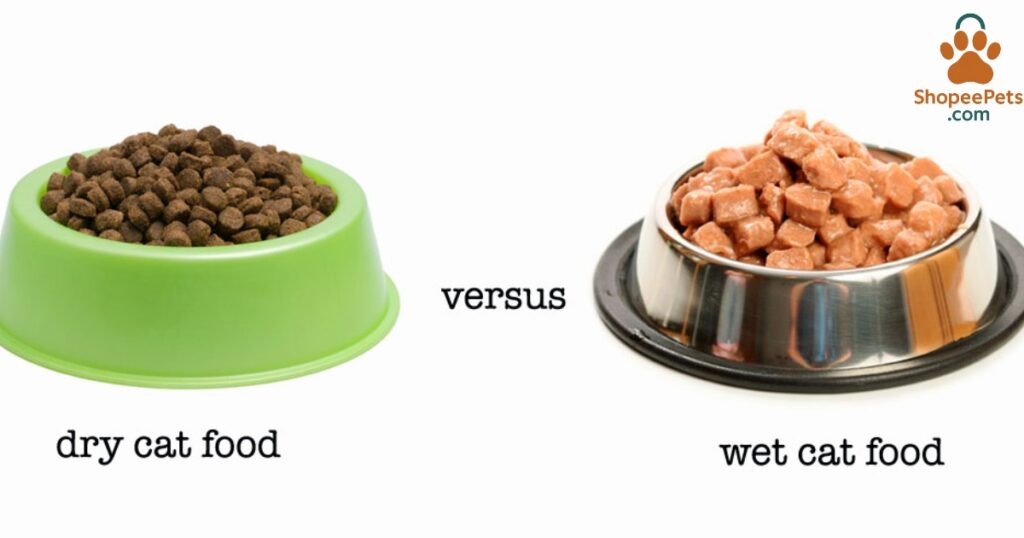
Comparison Table: Wet vs. Dry Cat Food
| Feature | Wet Cat Food | Dry Cat Food | Winner |
|---|---|---|---|
| Moisture Content | 70–80% | 10% | Wet |
| Shelf Life | Short (needs refrigeration) | Long (weeks/months) | Dry |
| Calories | Lower per gram | Higher per gram | Depends (Wet for weight loss, Dry for active cats) |
| Palatability | Strong aroma, cats love it | Moderate, some picky eaters refuse it | Wet |
| Cost | More expensive | Affordable | Dry |
| Dental Health | No benefit | Some chewing benefits | Dry |
| Feeding Flexibility | Spoils if left out | Can be free-fed | Dry |
Lifestyle Fit: Which Food Works Best for Different Owners?
- Busy Professionals: Dry food may be easier to manage.
- Health-Conscious Owners: Wet food supports hydration and prevents disease.
- Multi-Cat Homes: Dry food offers budget and convenience.
- Senior Cat Owners: Wet food helps with hydration and chewing.
📌 Explore Cat Food Guides – ShopeePets
Cost Analysis: Wet vs. Dry Cat Food
| Cat Weight | Daily Wet Food Cost | Daily Dry Food Cost | Monthly Difference |
|---|---|---|---|
| 10 lbs | $2.50 – $3.50 | $0.80 – $1.50 | $60–70 more for wet |
| 15 lbs | $3.50 – $4.50 | $1.20 – $2.00 | $80–90 more for wet |
📌 Note: Premium brands may cost even more, but quality often equals better long-term health.
Common Myths About Dry Cat Food
- ❌ “Dry food cleans teeth completely” – It helps slightly, but brushing and vet cleanings are still necessary.
- ❌ “Cats drink enough water with kibble” – Most cats do not drink sufficient water on their own.
- ❌ “Dry food is always cheaper” – Vet bills for urinary or kidney issues caused by dehydration can outweigh savings.
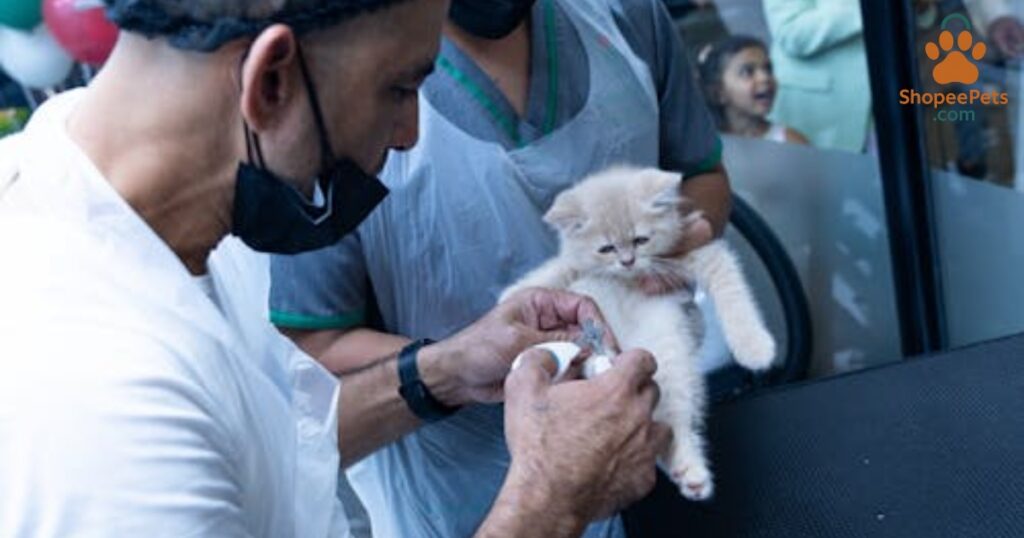
Should You Feed Wet, Dry, or a Combination?
One of the most common questions cat parents ask is: “Should I feed my cat wet food, dry food, or a combination of both?” The answer depends on your cat’s age, health condition, lifestyle, and your household budget. Let’s break it down in detail.
🥫 Wet Food for Cats
Wet food is typically packed in cans or pouches and has a high water content (about 70–80%). This makes it an excellent choice for cats who don’t naturally drink much water.
Advantages of Wet Food:
- Hydration: Helps prevent urinary tract problems and kidney disease.
- Palatability: Cats usually find it tastier and easier to chew.
- Portion Control: Cans/pouches are pre-measured, making feeding simple.
Disadvantages of Wet Food:
- Short Shelf Life: Once opened, it must be refrigerated and consumed quickly.
- Cost: Generally more expensive than dry food.
- Dental Health: Provides little to no chewing exercise, which may contribute to plaque buildup.
🍪 Dry Food for Cats
Dry cat food, also called kibble, has a low moisture content (about 10%). It is convenient, easy to store, and widely available.
Advantages of Dry Food:
- Convenience: Can be left out for free-feeding cats.
- Cost-Effective: Usually cheaper than wet food.
- Dental Benefits: Crunchy kibble can help reduce tartar buildup.
Disadvantages of Dry Food:
- Low Moisture: Cats may not get enough hydration, which can lead to urinary issues.
- Overeating Risk: Free-feeding can cause obesity if portions are not controlled.
- Quality Variations: Some brands contain too many fillers or artificial additives.
🥗 Combination Feeding (Wet + Dry Food)
For many cat owners, the ideal solution is a combination of both wet and dry food.
Why Combination Feeding Works:
- Balanced Nutrition: Dry food provides crunch + wet food ensures hydration.
- Flexibility: Offers variety in taste and texture, preventing food boredom.
- Health Benefits: Helps maintain urinary tract health while also promoting dental hygiene.
👉 Vet Insight: The American Veterinary Medical Association (AVMA) suggests that feeding a mix can give cats the benefits of both worlds.
Practical Example:
- Morning: Serve 1 pouch of wet food (for hydration).
- Evening: Offer a small portion of dry kibble (for chewing and slow energy release).
How Much to Feed Cats? (Portion Guide + Calories)
Feeding your cat the right amount of food is just as important as choosing the right type. Overfeeding leads to obesity, while underfeeding can cause malnutrition.
📏 General Feeding Guidelines by Cat Weight
Below is a simplified feeding chart (based on average indoor cats).
| Cat’s Weight | Calories Needed (per day) | Dry Food (kibble) | Wet Food (canned) | Combination (Example) |
|---|---|---|---|---|
| 5 lbs (2.2 kg) | ~150 kcal | 1/4 cup | 1/2 can (3 oz) | 1/8 cup dry + 1/4 can |
| 10 lbs (4.5 kg) | ~200–220 kcal | 1/3 cup | 3/4 can (3 oz) | 1/4 cup dry + 1/2 can |
| 15 lbs (6.8 kg) | ~250–280 kcal | 1/2 cup | 1 can (3 oz) | 1/3 cup dry + 1/2 can |
👉 This chart is an estimate. Always check the calorie content on the food label because different brands vary.
🔥 Calories & Activity Level
- Indoor cats (less active): 20 calories per pound of body weight.
- Outdoor cats (more active): 25–30 calories per pound of body weight.
- Senior cats: May need slightly fewer calories due to slower metabolism.
🐾 WSAVA Recommendations
The World Small Animal Veterinary Association (WSAVA) provides feeding guidelines that all pet parents should follow:
- Measure food portions with a standard cup or scale (don’t just “eyeball it”).
- Adjust amounts if your cat’s body condition changes.
- Feed based on ideal weight, not current weight (especially for overweight cats).
- Check Body Condition Score (BCS):
- Ribs should be felt but not seen.
- Waistline should be visible from above.
- Tummy tuck should be visible from the side.
🕒 How Often Should You Feed Cats?
- Kittens (<6 months): 3–4 small meals per day.
- Adult cats (1–7 years): 2 meals per day.
- Seniors (7+ years): 2 meals, with adjustments for health conditions.
👉 Free-feeding dry food is common but can lead to obesity. Scheduled feeding is usually better for weight management.
🐱 Practical Portion Example
Let’s say you have a 10-pound indoor cat:
- Needs ~200 calories per day.
- If your dry food has 400 kcal per cup:
- Cat needs about 1/2 cup daily (split into 2 meals).
- If your wet food has 90 kcal per 3 oz can:
- Cat needs about 2.25 cans daily.
- For combo feeding:
- 1/4 cup dry (100 kcal) + 1 can wet (90 kcal) = ~190 kcal total.
🐾 Expanded FAQs About Indoor Cat Nutrition
To help pet parents even further, here are 20+ common questions cat owners search for on Google and forums — answered in a human-written, professional, and SEO-friendly way.
1. What is the best cat food for indoor cats?
The best cat food for indoor cats is one that’s high in protein, moderate in fat, and low in carbohydrates. Brands like Royal Canin Indoor Cat Food, Hill’s Science Diet Indoor, and Purina Pro Plan Indoor are excellent choices. These are formulated to support healthy weight, coat quality, and digestion.
2. Should I feed wet or dry food to my indoor cat?
Both have benefits. Dry food helps with convenience and dental health, while wet food adds hydration and can help with weight control. Many vets recommend a combination of wet and dry for balance.
3. How much should an indoor cat eat per day?
Most indoor cats need 150–250 calories per day, depending on age, weight, and activity. Check the feeding guide on the food package and adjust based on your cat’s body condition.
4. Do indoor cats need special food?
Yes. Indoor cats are usually less active, so they benefit from foods with fewer calories, added fiber, and hairball control formulas.
5. What is the healthiest dry food for indoor cats?
Some of the healthiest dry food options include:
- Blue Buffalo Indoor Health
- Hill’s Science Diet Indoor
- Royal Canin Indoor 27
6. Is grain-free food better for cats?
Not always. Grain-free food isn’t necessary for most cats unless they have a specific allergy. What matters more is the protein quality and overall nutritional balance.
7. Do cats need wet food every day?
It’s not required, but giving wet food once or twice a day can improve hydration and help prevent urinary problems.
8. Can I feed my indoor cat human food?
It’s best to avoid it. Some human foods like chicken or salmon (plain, cooked) are okay occasionally, but many foods (onions, garlic, chocolate, grapes) are toxic to cats.
9. What cat food is best for hairball control?
Foods with extra fiber such as Purina ONE Hairball Formula or Hill’s Science Diet Hairball Control are designed to help indoor cats pass hairballs naturally.
10. How do I know if my cat is overweight?
Feel their ribs — if you can’t feel them easily, your cat might be overweight. A healthy indoor cat should have a visible waistline when viewed from above.
11. Should I feed my cat free-choice (all-day food) or scheduled meals?
Scheduled meals are better for weight management. Free-feeding can lead to overeating in indoor cats.
12. Is homemade food good for cats?
Homemade diets can work but are risky without proper balance. Cats require taurine, specific amino acids, and vitamins that are difficult to provide at home without a vet-approved recipe.
13. Do cats need milk?
No. Most adult cats are lactose intolerant. Giving cow’s milk can cause diarrhea and stomach upset. Instead, offer water or cat-safe milk alternatives.
14. How do I switch cat food brands safely?
Switch gradually over 7–10 days:
- Day 1–3: 75% old food + 25% new food
- Day 4–6: 50% old food + 50% new food
- Day 7–10: 25% old food + 75% new food
This prevents digestive upset.
15. What is the best food for indoor kittens?
Kittens need high-protein, calorie-rich food. Great options include:
- Royal Canin Kitten Indoor
- Purina Pro Plan Kitten
- Blue Buffalo Healthy Growth Kitten
16. Can indoor cats eat outdoor cat food?
Yes, but outdoor formulas often have higher calories for more active cats. Indoor cats may gain weight quickly if fed outdoor food.
17. How do I know if my cat’s food is good quality?
Look for:
- First ingredient = animal protein (chicken, salmon, turkey)
- AAFCO statement (“Complete & Balanced”)
- Moderate carbs and fillers
18. What food should I avoid for cats?
Avoid foods that contain:
- Artificial colors or preservatives
- Excessive fillers (corn, wheat, soy)
- Low-quality meat by-products
19. Can indoor cats eat raw food?
Raw diets are controversial. Some believe it’s natural, but vets warn of salmonella and bacteria risks. If feeding raw, ensure it’s commercially prepared and vet-approved.
20. Do senior indoor cats need different food?
Yes. Senior cats benefit from food with:
- Joint support (glucosamine, chondroitin)
- Lower calories
- Easily digestible protein
Brands like Hill’s Science Diet Senior are excellent.
21. Can indoor cats get enough exercise through diet alone?
No. While nutrition helps with weight control, cats also need playtime and activity to stay healthy. Use interactive toys and climbing trees.
22. What’s the best budget cat food for indoor cats?
Affordable yet quality options include:
- Purina ONE Indoor Advantage
- IAMS ProActive Health Indoor Weight & Hairball
These are budget-friendly and still nutritionally complete.
🐾 Final Conclusion: Choosing the Best Cat Food for Indoor Cats
Feeding your indoor cat isn’t just about filling their bowl — it’s about ensuring a long, healthy, and happy life. The best diet for an indoor cat should include:
- High-quality protein as the main ingredient.
- A balance of wet and dry food for hydration and dental care.
- Controlled calories to prevent obesity.
- Added fiber for hairball management.
- Proper vitamins, minerals, and taurine for heart and eye health.
👉 Remember: Always consult your veterinarian before making big changes to your cat’s diet.
If you want to explore more, check out trusted veterinary resources like the American Veterinary Medical Association (AVMA) and WSAVA Global Nutrition Guidelines WSAVA Nutrition Toolkit.
🔑 Meta Description
Looking for the best cat food for indoor cats? Our 2025 expert guide covers nutrition, wet vs dry, portions, vet tips & FAQs for a healthy, happy feline.


Naeem – Founder, ShopeePets
Helping pet lovers choose the best with honest product reviews, practical advice, and trusted guidance for every pet owner.
Visit ShopeePets.com →